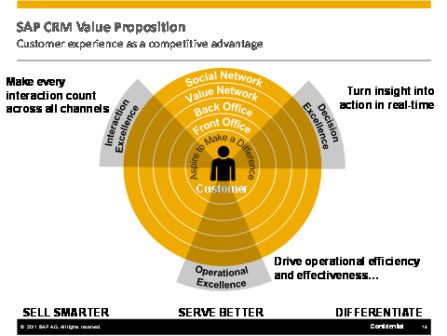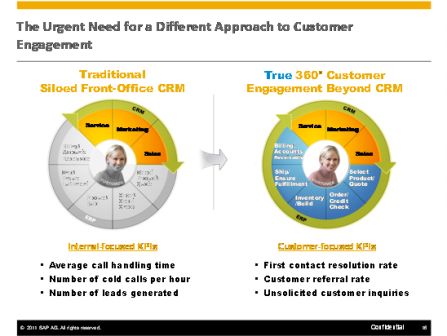I recently had the pleasure of speaking with Vinay Iyer, VP of SAP (News  - Alert) Global Marketing, co-author of an insightful new book, The Customer Experience Edge. We were joined by two SAP customers: Hillel Zafir, CTO of EMIYoshi, a provider of premium disposable plastic serving ware; and Kristen Woodard, Global Sales and Marketing, Welch Allyn, a global provider of the manufacture of medical devices for healthcare providers. The topic for the gathering was, “Secrets to for Delivering the 360° Customer Experience,” how the findings in the book were being put to practical use by leading edge customers.
- Alert) Global Marketing, co-author of an insightful new book, The Customer Experience Edge. We were joined by two SAP customers: Hillel Zafir, CTO of EMIYoshi, a provider of premium disposable plastic serving ware; and Kristen Woodard, Global Sales and Marketing, Welch Allyn, a global provider of the manufacture of medical devices for healthcare providers. The topic for the gathering was, “Secrets to for Delivering the 360° Customer Experience,” how the findings in the book were being put to practical use by leading edge customers.
SAP said interesting news was about to break that would be relevant to the topic at hand, so I held off. They did not disappoint. SAP just unveiled their strategy for how customers will be able to gain forward looking insights into the behavior of their customers through the new SAP BusinessObjects Predictive Analysis Software that is powered by the SAP HANA Platform. While a print full of words, what it means is that SAP users, running the software on SAP partner hardware, will be able to leverage big data to do enhanced intuitive predictive modeling with advanced analytic visualization. I will get to why this is important for the delivery of a 360° customer experience a bit later, but first some context.
Defining the customer experience
Jargon as always dominates technology markets. The “customer experience” space is no exception. As such it seems important to view the world as several sets of customers. They all need to have great experiences and those great experiences are very inter-related. The customers are:
- Internal to the enterprise, i.e., intimate customers of enterprise IT capabilities.
- Ecosystem partners (including supply chain ones, channels, et c.) who constantly interact with an enterprise’s people and business processes to achieve sales at optimized profit levels
- End user customers who interact with sales, marketing, accounts payable and receivable, and the “front end of the supply chain” aka contact centers.
Technology vendors focus on providing business optimization solutions for the first two groups so that their people can than provide great interactions that create compelling experiences for end users.
The dawning of the customer experience era
Back to SAP and Iyer. “The Customer Experience Edge: Technology and Techniques for Delivering an Enduring, Profitable, and Positive Experience to Your Customers,” is a fascinating distillation of original research conducted with Bloomberg (News - Alert) Businessweek Research. It includes interviews with over 50 C-levels and thought leaders, over 30 customer stories and 11 case studies (most with global household names). It is largely about the last bullet point relating to creating compelling experiences with end-user customers.
A telling finding was that 80 percent of respondents representing a broad swath of corporate and other interests said that getting closer to customers and providing them a differentiated experience was now a top strategic objective. Forget for a moment way this has not always been true. Realities are that the difficult economic challenges wrought by the global recession were one reason, but a huge factor was the Internet which has meant customers have more information and more choices, are always a click away from a competitor, and are increasingly disloyal if not properly nurtured. Once the cost-cutting was over, priorities shifted. Not impressed? How about the finding that less than 20 percent thought their organization was doing a good job at improving customer experiences? Customer intimacy as a priority had a huge gap to cross to meet customer expectations, and it seems we have reached a tipping point where failure to act is not an alternative.
The research also found that market dynamics mean the bar of expectations is always moving higher. We are still at the on-ramp stage of dealing with such things as social networking, the consumerization of IT, video on everything and everywhere, and are adjusting to real time being the only time that seems to matter. It revealed four customer experience “essentials” that organizations of all sizes need to consider first and foremost in transforming their external-facing end-user customers:
- Reliability
- Relevance
- Responsiveness
- Convenience
SAP says that, “Use of the right technologies is critical to delivering consistent, scalable and profitable customers.” In fact, they presented a terrific graphic on this which they have allowed me to reproduce:

In recognition that we are at a tipping point SAP is saying, and the two customers at the session validated, that enterprises need to change their approach to customer engagement. The challenge lies in the following graphic:

In short, contact centers cannot provide superior customer experiences unless/until the silos are broken down. There needs to be a way for all of the interactions, on all corporate data bases can be (to use another popular jargon term) “federated.” In fact, going back to the first two audiences of customer experience, it means that the structured and un-structured data from various parts of an enterprise —from ERP systems, inventory and delivery databases, sales and marketing, etc. — need to be inter-meshed, and capable of providing useable information on-demand and in real time.
Enter Big Data
The SAP introduction of SAP BusinessObjects Predictive Analysis Software that is powered by the SAP HANA Platform is a critical part of the move toward federation that can enable enterprises to deliver to everyone who needs it, but particularly those who touch customers directly and often, the information and insights they need to up their game in engaging customers. It is the HANA Platform that provides the capabilities to crunch the big numbers and enable the ability to visualize data. Predictive modeling is only one piece of the puzzle. As if not more important is the ability for customer-facing employees to be able to provide inquiring minds answers to their questions at a level of detail previously unattainable in real or near real time.
None of this is going to be easy. I liked the way Marc Alvarez, Senior Director for Reference Data Infrastructure at Interactive Data recently blogged in discussing big data in the context of financial institutions:
“When looked at as a whole, this positions big data at a very interesting intersection between data content, technology, and analytical capability. It involves the pre-processing of data before a firm makes strategic decisions based on it. The pressure to keep pace and thrive in this environment is going to place a premium on having the right software and other infrastructure in place. For data suppliers this means being able to offer a far wider (as well as deeper) universe of content on demand and in a form that is easily consumed. The historical partnership between supply and application of data is going to become even more important and sophisticated as a result.”
SAP, coming from its historical core competencies of enterprise resource planning (ERP), business process automation (BPA) and customer relationship management (CRM), believes that it has a meaningful leg up in the market. It’s growing leveraging of the HANA in-memory distributed data platform is destined to make it a key player in the evolving big data space.
What was most interesting about the session with SAP and its reference accounts was what the two customers had to say. EMIYoshi’s Zafir stated, “We evaluated a number of vendors and found SAP met our needs based not only on functionality, but also on price its support from the company and its community.” Woodward noted that, “We are taking a gradual approach but are extremely pleased with the flexibility SAP has given us not just with our customers but with our internal stakeholders as well.”
One factoid that emerged in the discussion really was a grabber. Iyer noted that there are now 8,000 executives around the world with “customer experience,” in their titles. He said that these were executives empowered to look at how improving the experiences of the internal enterprise users to meet their needs and the needs of their ecosystem partners were having a real impact on improving the way end users experience a company’s people, products and services, and business processes.
I asked Iyer how much had changed since work started on the book almost two years ago. He responded, “It is hard to keep up with the pace of technology change, but the fundamentals of what will be required to provide improved customer experiences remain the same. It is not just in having the right tools. It is in knowing what you have, what it tells you and then knowing what to do with and about it. That is how you go beyond traditional customer service and get to providing 360° customer experiences.”
Not a bad place to end. For that matter it happens to be a good place to start as well.
Edited by Jennifer Russell
